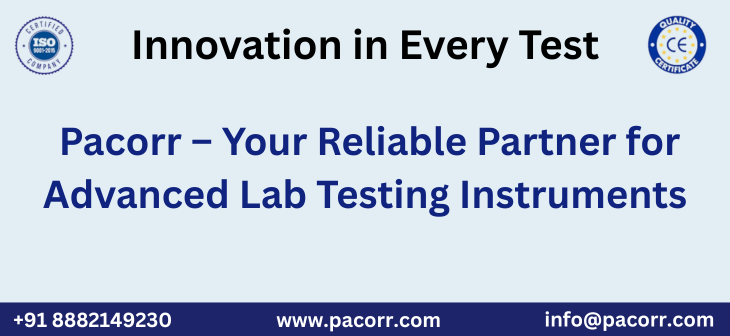
Pacorr has emerged as a trusted provider in the field of testing instruments, particularly for industries that demand high-performance solutions for packaging validation. With its precision-engineered vibration table, Pacorr delivers a critical tool that replicates the real-world conditions packaging experiences during transit. This ensures that businesses can reliably test the durability and structural integrity of their packaging materials before they hit the supply chain.
As global commerce expands and supply chains stretch across continents, packaging needs to do more than just contain a product. It must withstand vibrations, shocks, and unpredictable movements during shipping. Here, the role of a vibration table becomes central to the quality assurance process.
Understanding the Purpose of a Vibration Table in Packaging Validation
A vibration table is a mechanical device designed to simulate the vibrational forces that packages endure during transportation. Whether goods are moved by road, rail, sea, or air, they are subject to a range of vibrational frequencies. Over time, these forces can lead to weakened packaging, compromised seals, and in worst-case scenarios, damaged products.
By placing packaged goods on a vibration table, manufacturers and packaging engineers can simulate these stresses in a controlled environment. This allows them to identify flaws, improve designs, and ensure that packaging solutions are robust enough to endure actual shipping conditions.
The Benefits of Using a Vibration Table for Packaging Testing
There are multiple advantages to incorporating vibration table testing into the packaging validation process. These benefits go beyond quality control—they directly impact business efficiency, customer satisfaction, and brand reputation.
1.Realistic Transport Simulation
A vibration table helps simulate the exact conditions that packages face during shipment. By adjusting the vibration frequency and amplitude, testing teams can mimic different modes of transport. Whether it is a bumpy road or turbulence during air freight, these settings help predict packaging behavior in real scenarios.
2.Reduced Product Damage
One of the primary reasons companies turn to vibration tables is to minimize the risk of product damage. Damaged goods lead to customer complaints, increased return rates, and financial losses. By proactively testing packaging durability, manufacturers can fine-tune their materials and structural designs to offer better protection.
3.Compliance with Industry Standards
Many industries follow strict regulations and international standards for packaging and transport. Using a vibration table aligns your validation process with ISO and ASTM testing standards, enhancing your credibility and helping you meet global compliance requirements.
4.Cost Savings in the Long Run
While there is an upfront cost in purchasing and operating vibration testing equipment, the long-term savings far outweigh it. Improved packaging design leads to fewer damaged goods, reduced returns, and less wastage. Over time, this improves your bottom line significantly.
5.Data-Driven Packaging Design
Vibration tables allow for comprehensive testing, generating data on how packaging materials react under stress. Engineers can use this information to make informed design changes. It transforms packaging from a static container to a dynamic, engineered solution tailored for resilience.
6.Brand Trust and Customer Satisfaction
When products arrive in perfect condition, customers notice. A solid packaging strategy validated by vibration testing builds brand reliability and trust. It shows that the company is committed to quality at every level, from product development to final delivery.
Industries That Benefit from Vibration Table Testing
A wide range of industries benefit from using vibration tables as part of their packaging validation protocol.
- Pharmaceuticals: Sensitive medications and medical devices require stable packaging to maintain efficacy and sterility.
- Electronics: Fragile components such as circuit boards and smartphones must be protected from shocks and vibrations.
- Automotive: Spare parts and assemblies are often heavy and oddly shaped, making them susceptible to shipping damage.
- Consumer Goods: From appliances to personal care items, packaging must endure various transport scenarios to meet retail expectations.
- Food and Beverage: Packaging for perishable goods must maintain integrity to prevent spoilage and contamination.
Key Features of a High-Quality Vibration Table
Not all vibration tables are built the same. High-quality models, like those developed by Pacorr, often include these essential features:
- Adjustable frequency and amplitude controls
- Digital display for precise monitoring
- Rigid platform to accommodate different package sizes
- Low noise operation for lab settings
- Durable build for long-term testing reliability
These features ensure accurate simulation of transit conditions and long-lasting usability, making the investment worthwhile for high-throughput packaging operations.
How to Integrate Vibration Testing into Quality Assurance
Integrating a vibration table into your quality assurance workflow begins with setting clear testing parameters. Define what modes of transport the product will experience and adjust the machine accordingly. Record observations during testing and assess for signs of structural failure, leakage, or distortion.
From there, share findings with your packaging design and procurement teams. Adjustments in material, cushioning, or sealing methods can be made based on real testing data. Repeat tests as needed to validate changes before full-scale deployment.
- Experience: Testing teams gain hands-on insight from repeated trials, learning how packages behave under real-world stresses.
- Expertise: Engineers develop specialized knowledge of materials and packaging systems.
- Authoritativeness: Compliance with international standards and use of precise instruments like Pacorr’s vibration table reinforce your credibility.
- Trustworthiness: Transparent, documented test processes build confidence with partners, clients, and end consumers.
Final Thoughts on the Importance of Vibration Testing
Packaging validation using a vibration table is more than a regulatory step it is a strategic tool for delivering better customer experiences, reducing losses, and achieving operational efficiency. Pacorr has positioned itself at the forefront of this domain by offering vibration tables that align with the practical needs of manufacturers and quality control professionals.
With increasing global demand for reliable, damage-free deliveries, integrating a vibration table into your testing routine ensures that your packaging is not just good-looking but genuinely protective. It is a proactive move toward excellence, driven by data, and supported by proven testing methodology.
Whether you operate in pharmaceuticals, electronics, automotive, or consumer goods, investing in vibration-based packaging validation is no longer optional. It is a necessity for those aiming to lead in product quality, logistics reliability, and customer satisfaction.
Thanks to Pacorr Testing instruments, we have all the required quality testing instruments that have helped us to ensure the best quality delivered to our clients.

Danish
Fair Exports Pvt. Ltd.

